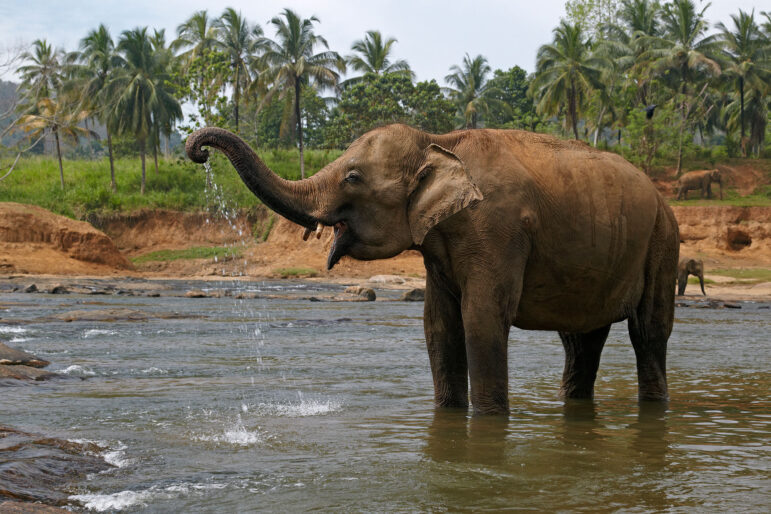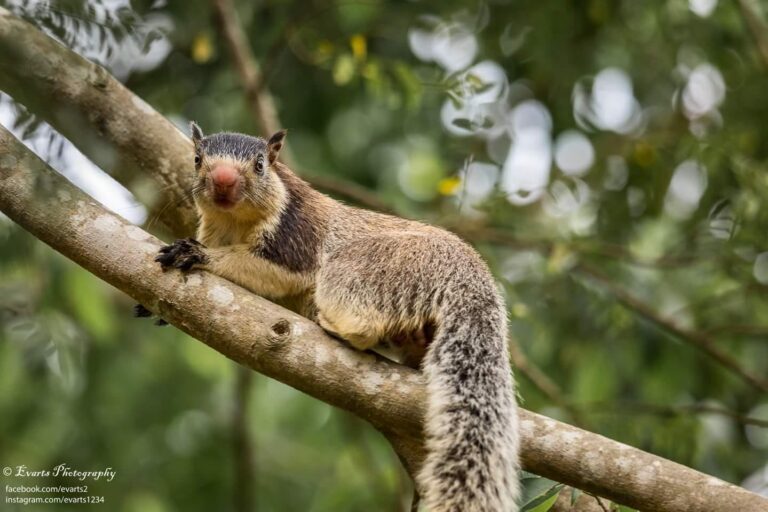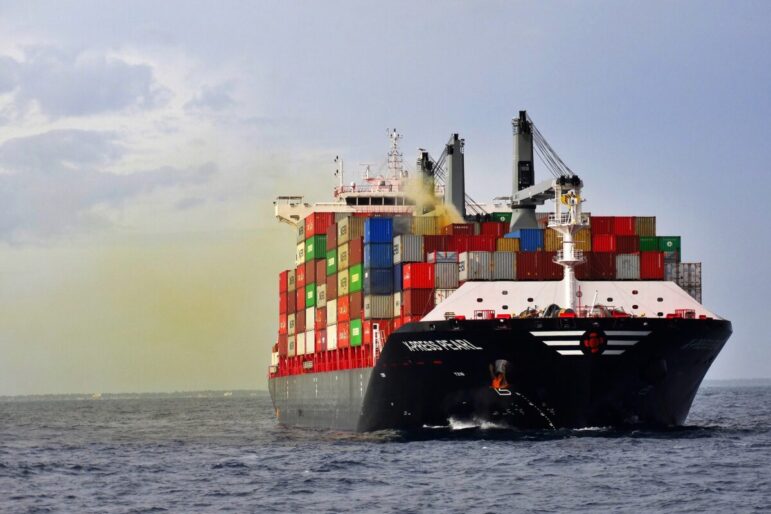
Indian elephant (Elephas maximus) from Pinnawala Orphanage, Sri Lanka.
Mongabay has long reported on the socio-environmental issues in the biodiverse hotspot Sri Lanka. However, hiring our first Sri Lanka-based staffer, Dilrukshi Handunnetti, in 2019 strengthened our ability to report from the island consistently. Since then, Mongabay has pioneered dedicated environmental news coverage that has raised public awareness about globally significant conservation issues and fostered relationships with prominent South Asian media outlets.
Amid challenging times, from COVID-19 to widespread national instability, Mongabay’s presence within the country has been increasingly impactful. Despite these disruptions, we’ve been able to provide paid reporting opportunities to local journalists and, in doing so, produce news from a unique environmental lens. Through sustained media attention on climate change impacts, habitat loss and wildlife conflicts, Mongabay’s reporting has consistently informed vital decisions, spotlighting Sri Lanka’s unique biodiversity and local people protecting nature, as well as elevated awareness of the country’s ecological importance internationally. This coverage has inspired real-world impacts, including the examples shared below.
Informing other journalism outlets

The grizzled giant squirrel (Ratufa macroura) is Sri Lanka’s national animal but has become problematic to coconut planters who want the squirrel population brought under control. Image courtesy of Evarts Ranley.
Our stories, spanning species discoveries to socio-environmental challenges, have inspired follow-up pieces in major English newspapers and online news sites.
As Mongabay’s reputation in Sri Lanka has grown, so has outreach to Mongabay from other media outlets regularly asking for source information and photographs. For instance, following our story about the alarming number of endangered manta and devil rays caught by artisanal fisheries, The Guardian’s local contributor consulted Mongabay contributor Malaka Rodrigo to inform the Guardian’s story. The op-ed in The Island is another example of other media using our reporting. Similarly, several scientists who run citizen science initiatives have requested translations of Mongabay’s stories for use in various community and youth awareness programs and sources for academic reports.
Furthermore, numerous mainstream outlets have republished or translated our stories into the two major languages, Sinhala and Tamil. For instance, “New rainforest gecko joins growing list of reptiles unique to Sri Lanka” was republished in Sri Lanka’s highest-circulating English weekly, Sunday Times. Likewise, “An ill-deserved reputation threatens Sri Lanka’s ‘secretive snake,” was republished in the largest Sinhala language newspaper, Lankadeepa.
Globally, Mongabay’s stories gain traction, with republication or reference by international outlets, including The Indian Express, News9, Lankaweb, EastMojo, the UN Convention of Biological Diversity listserv, EcoWatch, Agence France Presse, MSN, South China Morning Post, News24, Eco-Business, The Wire Science, Bloomberg CityLab, and National Public Radio.
Key decision-makers also rely on Mongabay’s reportage. Parliamentarians have requested our stories for reference. For example, a court decision required the Centre for Environmental Justice (CEJ) to collaborate with other stakeholders to address human-elephant conflict in Sri Lanka. CEJ requested Mongabay’s input based on our reporting, which has consistently tracked and explored the issues and their drivers from various perspectives.
Impact
While it often takes time for journalism’s impact to transpire, sometimes coverage spurs immediate action. Such was the case following our story on a controversial four-day music festival. Deep Jungle Music and Cultural Festival 2023 was scheduled on private land neighboring Gal Oya Forest Reserve and Hurulu Eco Park – home to numerous species, including the Sri Lankan elephant. A day after Mongabay published the story, festival organizers called off the event, and one of them reached out to Mongabay’s contributor to play down the issue to avoid more public pushback and publicity. Event protesters told Mongabay the story helped pressure the organizers to reconsider the event’s location.
Covering the Sri Lankan elephant

The Department of Wildlife Conservation moves wild elephants that may be damaging crops and harming people from their home range to another area. Image courtesy of Shashikala Rathwaththa.
Sri Lankan elephants – an Asian elephant subspecies – have received extensive coverage, including increased conflict with humans and disappearing habitat. This coverage started with a disturbing story on explosive devices concealed in bait for bushmeat hunting. According to the Department of Wildlife Conservation, these explosives have overtaken gunshot injuries as the primary cause of elephant deaths in Sri Lanka. Our coverage heightened awareness around this issue, and follow-up articles published in Newsweek and leading international news agency Agence France Presse cited it as the primary news source. We raised the issue again when we reported on the Sri Lanka Wildlife Conservation Society’s efforts to monitor and respond to the increased use of explosive baits in and near Wasgamuwa National Park.
We also highlighted innovative conservation technologies to reduce human-elephant conflict, such as GPS-enabled collars to monitor and inform development initiatives to avoid areas with high potential conflict. This study prompted the Sri Lankan government to change zoning plans around Mattala International Airport to accommodate the local elephant population’s needs. While the overlap between human settlements and elephant habitat is a long-standing problem, technology and new data on elephant movement helped inform the declaration of a managed elephant reserve. Still, the issue remains; at least one elephant death a day was recorded in the first three months of 2023, nearly half due to human causes, putting the country on track for a record death toll from human-elephant conflict. The gravity recently spurred the government to set up a committee to implement a 2020 draft national action plan to tackle the problem.
By working with Mongabay, contributing journalists have improved their capacity to report on complex, controversial environmental issues, receiving public recognition, including invitations to participate in various solution-seeking efforts by environmental NGOs on conservation matters as well as a special committee appointed to seek solutions to human-elephant conflicts.
X-Press Pearl cargo ship fire and spill

The X-Press Pearl had been newly commissioned just four months before it caught fire and sank. Image by Isuruhetti via Wikimedia Commons (CC BY-SA 4.0).
Perhaps the greatest demonstration of Mongabay’s role in increasing awareness and accountability in Sri Lanka, is our ongoing coverage of the X-Press Pearl. In 2021, the cargo ship caught fire and spilled tons of contaminated plastic pellets off Sri Lanka’s coast, making it the worst maritime environmental disaster in the country’s history. Experts have regularly referred to Mongabay’s coverage on the incident during live television and radio discussions, especially on calculating compensation for environmental damage and the questions of short- and long-term environmental impact. Local scientists and maritime lawyers lauded the coverage for depth and accuracy.
Other media outlets, like UPI, cited it, inspiring follow-up articles in Nature World News, Business Insider, UK tabloid The Sun, Live Science, and The Washington Post. Additionally, National Public Radio’s (NPR) Morning Edition producers in Washington DC and Here & Now midday show reached out on multiple occasions for interviews and information. NPR’s network of over 1,000 public radio stations amplified our original reporting to approximately 120 million people.
Given Mongabay’s specialized focus, we’ve been able to provide sustained coverage – something many other media outlets cannot do. After our initial article called international attention to the situation, we published a follow-up article delving further into hazardous materials onboard with a high risk of ocean pollution.
Quality original reporting has played an essential role in holding companies accountable for their activities and the associated environmental impacts. For instance, in one story, the Colombo-based Shippers Academy chief executive, Rohan Masakorala, called for a transparent and efficient investigation to prevent similar incidents. He told Mongabay it’s essential to identify communication gaps and whether parties responded to the distress call. In a statement, X-Press Feeders, the ship’s owner, pledged its support for the ongoing investigation into the incident. Mongabay has continued to report on the incident’s aftermath, from the resulting lawsuit and pursuit of compensation to ongoing research into the total environmental damage done.
Journalism in education
Use of Mongabay’s reporting by the private and public sector has also grown. For example, the Parrotfish Collective sought advice on how to improve their efforts, as well as converted Mongabay content into public awareness materials. Similarly, Sri Lanka Scientist, the premier local language science publication, sought collaboration with Mongabay for online discussions about tips on reporting on science and the environment. Leading scientists Enoka P. Kudawidanage, Hemantha Withanage, and Kanishka Ukuwela have informed Mongabay that they use our reporting for their public awareness efforts. As university professors, Kudawidanagae and Ukuwela also use the stories as educational materials in their classes.
Elevating understanding
Mongabay’s reporting efforts have given experts a voice and called attention to their work.. A commentary by environmental lawyer, lecturer and naturalist Jagath Gunawardana on rediscovering an endemic plant known as the Sri Lanka legume was referred to by a technical committee appointed to reassess the feasibility of a highway extension project. Likewise, Mongabay reported on Hiranya Sudasinghe’s research, a molecular biologist at the University of Peradeniya, who published on the genetic diversity of an endemic freshwater fish. Following our coverage, Rohan Pethiyagoda, a global expert in freshwater fish and former deputy chair of the IUCN’s Species Survival Commission, told Mongabay these new studies by young scientists were bringing Sri Lankan fish studies into the 21st century, casting a new light on our understanding of species.
Future Sri Lanka reporting
As one of Earth’s most biologically rich areas and a region where Mongabay has proven that our specialized journalism can have an outsized impact, we aim to maintain a presence in Sri Lanka. Mongabay is eager to do more in-depth stories in addition to our research-centric coverage and to ensure the news produced has as many diverse and underrepresented perspectives as possible, including those of women and local communities.
Support independent environmental journalism
If you are interested in helping sustain independent news, there are two excellent ways you can do so with Mongabay. First, consider making a donation, which directly helps us continue to produce high-impact journalism from Nature’s frontline. Second, subscribe to Mongabay’s newsletter to get the latest environmental news delivered right to your inbox.
About Mongabay
Mongabay is a nonprofit environmental science and conservation news platform focused on providing cutting-edge independent journalism from Nature’s frontline. We pride ourselves on producing reporting that has substantial, tangible impacts around the world.